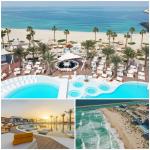In the early 1970s, when Dubai was still a modest trading town with limited infrastructure, a bold vision was set in motion — one that would forever redefine its skyline and global image. That vision was the Dubai World Trade Centre (DWTC), a tower that would come to symbolize ambition, progress, and the power of thinking far ahead of its time.
The concept of the World Trade Centre emerged under the leadership of the late Sheikh Rashid bin Saeed Al Maktoum, who sought to position Dubai as a commercial gateway between East and West. At that time, such a massive undertaking was seen by many as risky and unnecessary. Dubai was still years away from its oil boom. The tallest building in the region was just a few stories high. And Sheikh Zayed Road, now one of the busiest highways in the world, was little more than a two-lane stretch of tarmac through the desert.
Still, construction began in 1974, and five years later, in 1979, the Dubai World Trade Centre was officially inaugurated by Queen Elizabeth II. Standing at 149 metres, the 39-storey tower was the tallest structure in the Middle East at the time. Its solitary presence, surrounded by empty desert, marked it as a futuristic outlier in a region just beginning to open itself to international commerce and investment.
What seemed like a gamble back then soon turned into one of the most successful urban development stories in the world. The tower, designed by British architect John R. Harris, began attracting international companies that were eager to establish a presence in the growing Gulf economy. Diplomats, traders, investors, and multinational businesses soon followed, and before long, the Dubai World Trade Centre had established itself as a major anchor in the city’s economic strategy.
The DWTC was never just a skyscraper. It became a symbol of possibility — a concrete statement that Dubai was ready to welcome the world. Over the decades, it expanded in scale and significance, growing into a vast complex of exhibition halls, conference facilities, office spaces, hotels, and commercial towers. It laid the foundation for Dubai’s transformation into a globally connected business metropolis.
As Dubai's reputation as a regional and international trade hub grew, so did the World Trade Centre's role in facilitating that growth. The area surrounding the tower, once barren land, began to flourish. Today, what was once just a single building surrounded by sand has evolved into a dense and vibrant district filled with skyscrapers, luxury hotels, restaurants, and transport networks. Sheikh Zayed Road now serves as the central spine of the city, and the Dubai World Trade Centre remains its most iconic and enduring landmark.
The DWTC is now far more than just an office tower. It hosts over 500 events annually, drawing millions of business travelers, industry professionals, and exhibitors from around the world. Trade shows like GITEX Global, Arabian Travel Market, Gulfood, and Arab Health are all held here, helping the city generate significant revenue and forge powerful international connections across sectors such as technology, tourism, energy, healthcare, and real estate.
The expansion of the centre over the years has been nothing short of remarkable. Facilities like the Sheikh Rashid Hall, Sheikh Maktoum Hall, and the Za’abeel Halls have transformed the complex into one of the largest and most versatile event venues in the region. These spaces allow Dubai to host everything from international exhibitions to global summits and entertainment events.
A significant milestone in the DWTC's evolution was the launch of the One Central development — a mixed-use district that combines Grade A offices, hotels, residential apartments, and retail destinations. This modern addition has added new energy to the World Trade Centre area, attracting tech firms, startups, creative agencies, and corporate giants alike. With direct access to the metro, airports, and downtown areas, One Central has become one of the most connected business districts in the region.
Another pivotal move was the creation of the Dubai World Trade Centre Authority, which governs the free zone within the DWTC area. The authority allows businesses, including those in emerging sectors like cryptocurrency and blockchain, to operate under a special regulatory environment, encouraging innovation and entrepreneurship. The DWTC Free Zone now provides licensing, regulatory frameworks, and world-class infrastructure tailored to meet the needs of modern companies in technology, finance, media, and beyond.
During the COVID-19 pandemic, the DWTC demonstrated remarkable resilience and social responsibility by quickly converting part of its exhibition halls into a temporary field hospital. This emergency facility provided critical care to thousands of patients at the height of the health crisis, showcasing the centre’s adaptability and unwavering support for the community.
The success of the Dubai World Trade Centre is deeply tied to the broader story of Dubai itself. What began as a solitary vision has now become a thriving ecosystem — a place where global businesses launch new ventures, policymakers shape future strategies, and innovators bring fresh ideas to life. The DWTC remains central to Dubai’s ambitions to diversify its economy, attract foreign direct investment, and establish itself as a global innovation and business hub.
Today, walking through the bustling corridors of the Dubai World Trade Centre, one can witness the diversity, dynamism, and ambition that define modern Dubai. From cutting-edge expos and international conventions to the daily activity of thousands of professionals working in its towers, the DWTC stands not just as a historic structure but as a living symbol of what Dubai has achieved — and what still lies ahead.
In many ways, the journey of the DWTC mirrors the journey of the city it calls home. It began as a bold experiment in a quiet desert town. Now, it sits at the heart of one of the world’s most vibrant, futuristic, and fast-growing cities — a permanent reminder that with vision and determination, even the most ambitious dreams can rise from the sand and reach for the sky.










